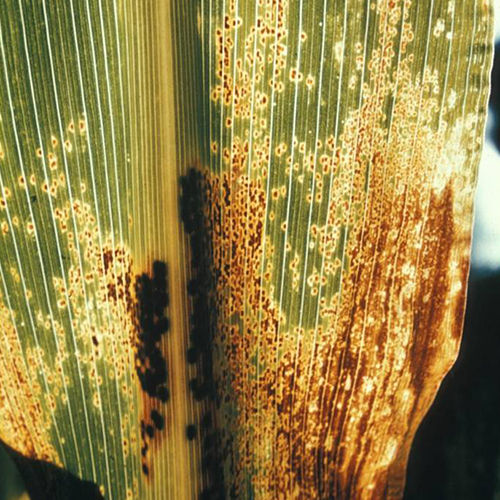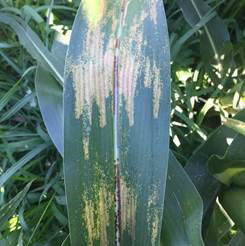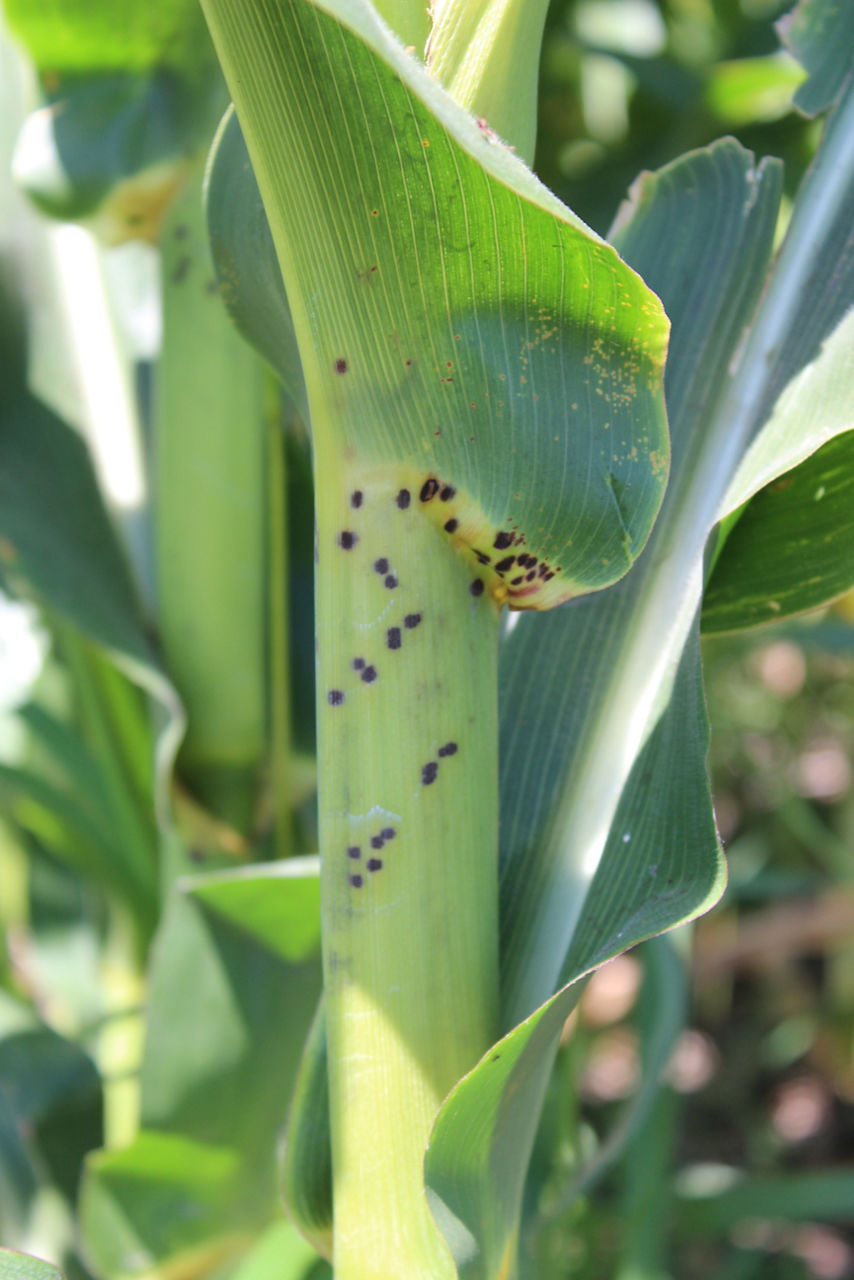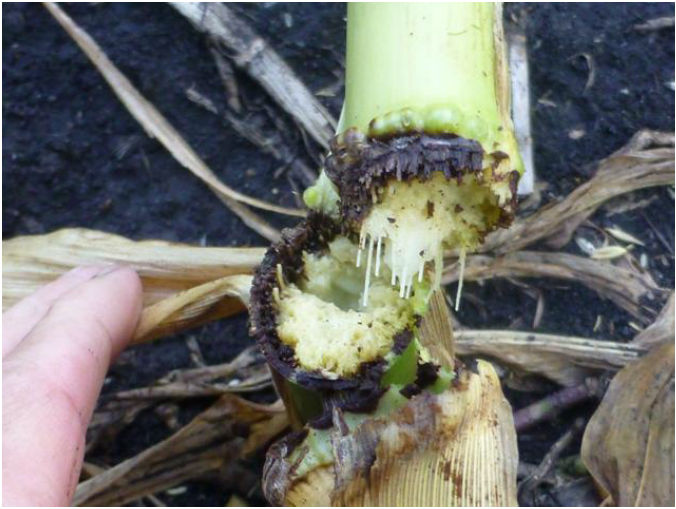3 MIN READ
Physoderma Brown Spot and Stalk Rot in Corn
November 10, 2021
Physoderma brown spot (PBS) and physoderma stalk rot (PSR) are fungal diseases caused by the Physoderma maydis pathogen. PBS was not previously considered an economically important disease in the Midwest. However, 2020 reports show physoderma caused corn yield losses of 600,000 bushels in the United States.1
Symptoms
Foliar symptoms of PBS include numerous small (about 1/4 inch in diameter) yellowish to brown, round to oval lesions that usually occur in broad bands on leaves (Figure 1 and 2).2 Dark purplish to black lesions can also appear on the leaf midrib, stalk, leaf sheath, and husks (Figure 2). Lesions on the leaf midrib often coalesce to form larger dark blotches. Symptoms typically appear prior to tasseling. Foliar leaf symptoms appear similar to eyespot and southern rust (Figure 3); however, those diseases do not have dark, larger lesions on the leaf midrib.2

Figure 1a. Physoderma brown spot lesions.

Figure 1b. Note the darker, larger lesions on the leaf midrib.

Figure 2a. PBS leaf lesions appearing in a broad band.

Figure 2b. Larger, darker, purplish PBS lesions on the leaf sheath. Photo courtesy of Dr. Carl Bradley, University of Kentucky.
PBS leaf symptoms are often not visible on plants expressing physoderma stalk rot (PSR).2,3 Plants affected with PSR often appear healthy, however nodes are weakened and often the stalks snap in two at the lower nodes. Stalk nodes where the breakage occurs are black and rotted (Figure 4).
Figure 3a. Left: Southern Rust. Right: Eyespot.

Figure 4. Physoderma stalk breakage. Photo courtesy of Dr. Alison E. Robertson, Iowa State University.

Figure 5. Rust-colored sporangia at perimeter of node on overwintered stalk debris.
Disease Development
The pathogen survives in overwintering structures called sporangia, which can be viable for 2 to 7 years in crop residue from infected plants (Figure 5).4 The sporangia are wind dispersed or splashed onto corn plants. For these reasons, PBS may be more common in continuous corn and conservation tillage systems.
Infection commonly occurs in the plant whorl where water tends to accumulate from rain and irrigation. Since the pathogen requires a combination of sunlight, water, and warm temperatures (73 to 86°F) to germinate, infection in the whorl may cause lesions in bands across the leaf (Figure 2).3,5
Plants are most susceptible during early vegetative growth (V5 to V9 stages) and may become more resistant with age.2,4 Stalk rot develops when nodes 6 and 7 have physoderma infection.4
Management
Management of PBS and PSR includes reduction of available inoculum with crop rotation or tillage although sporangia can be transported long distances and live for multiple years in the soil.3,4 Tolerant products should also be planted to help reduce infestations.5 Products are being evaluated for their reactions to the stalk breakage symptoms. Delaro® 325 SC fungicide and Delaro® Complete fungicide are labeled for PBS and are effective methods of control when applied at early vegetative corn stages (V4-V7). Three modes of action from Delaro Complete fungicide provide a consistent plant health increase under a variety of environmental conditions.
Sources:
1 Mueller, D., Wise, K., Sisson, A., et. Al. 2021. Corn disease loss estimates from the United States and Ontario Canada – 2020. Crop Protection Network. https://cropprotectionnetwork.org/resources/publications/corn-disease-loss-estimates-from-the-united-states-and-ontario-canada-2020.
2 Robertson, A.E., Jesse, L., Munkvold, G., Salaau-Rojas, E., and Mueller, D.S. 2015. Physoderma brown spot and stalk rot of corn caused by Physoderma maydis in Iowa. Plant Health Brief BR-15-0003. Plant Health Progress. Vol. 16, No. 2. The American Phytopathological Society. https://www.plantmanagementnetwork.org/
3 Jackson-Ziems, T. 2020. Physoderma brown spot. 2020 Crop Production Clinic Proceedings. University of Nebraska-Lincoln. http://cropwatch.unl.edu/plantdisease/corn/physoderma
4 Robertson, A. 2015. Physoderma brown spot and stalk rot. Integrated Crop Management. Iowa State University. https://crops.extension.iastate.edu/cropnews/2015/07/physoderma-brown-spot-and-stalk-rot
5 Wise, K., Kennedy, B., Mehl, K., and Bradley, C.A. 2018. Physoderma brown spot. University of Kentucky. ppfs-ag-c-07. https://plantpathology.ca.uky.edu/
Web sources verified 11/13/21.
130819060802
6005_S3